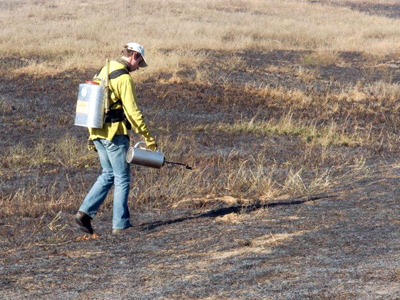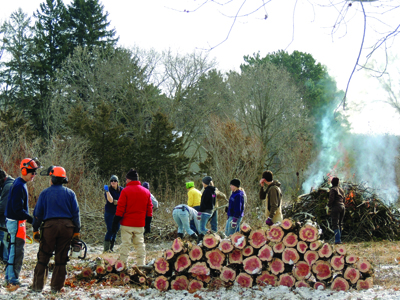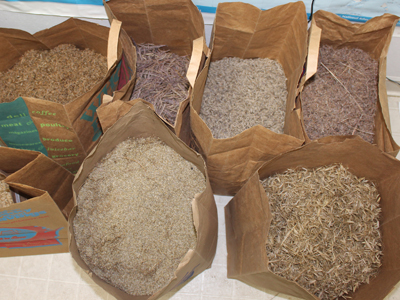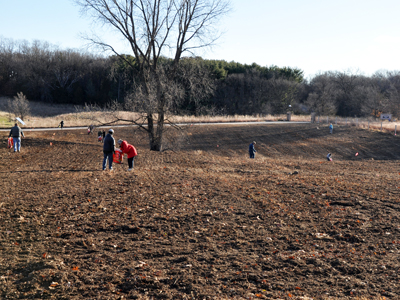What more delightful avocation than to take a piece of land and by cautious experimentation to prove how it works? What more substantial service to conservation than to practice it on one’s own land? – Aldo Leopold
 I arrived at the International Crane Foundation for my internship with the Field Ecology Department in late February 2015, after graduating from the University of Southampton (UK) in the previous year. I was committed to a career in conservation and wanted to gain experience internationally. Once I saw the setting for my new workplace, I knew I would be happy – the headquarters site in Wisconsin is set in a sprawling and beautiful landscape of woodland, wetland, and prairie. Previously farmland, most of the land has been restored to a natural state as part of the Ecosystem Restoration Program that was initiated in 1979. Various experimental plantings have also provided valuable information on restoration techniques, and the site now serves as a model for future restoration efforts. On my first exploration of the grounds, my roommate pointed out the prairie plants poking up through the snow. I was intrigued…
I arrived at the International Crane Foundation for my internship with the Field Ecology Department in late February 2015, after graduating from the University of Southampton (UK) in the previous year. I was committed to a career in conservation and wanted to gain experience internationally. Once I saw the setting for my new workplace, I knew I would be happy – the headquarters site in Wisconsin is set in a sprawling and beautiful landscape of woodland, wetland, and prairie. Previously farmland, most of the land has been restored to a natural state as part of the Ecosystem Restoration Program that was initiated in 1979. Various experimental plantings have also provided valuable information on restoration techniques, and the site now serves as a model for future restoration efforts. On my first exploration of the grounds, my roommate pointed out the prairie plants poking up through the snow. I was intrigued…
 In addition to regular duties, interns at the International Crane Foundation conduct an independent project during their tenure. This allows for personal development and exploration of particular interests. I was seeking new skills in applied ecology and project management, so when a prairie restoration project was suggested, I eagerly took on the challenge. A great many factors must be considered when conducting a restoration. How big is the site? How should it be prepared for planting? How much seed? Which species should be planted? When do tasks need to be completed?
In addition to regular duties, interns at the International Crane Foundation conduct an independent project during their tenure. This allows for personal development and exploration of particular interests. I was seeking new skills in applied ecology and project management, so when a prairie restoration project was suggested, I eagerly took on the challenge. A great many factors must be considered when conducting a restoration. How big is the site? How should it be prepared for planting? How much seed? Which species should be planted? When do tasks need to be completed?
To answer some of these questions, I looked to the findings from the Ecosystem Restoration Program. For the 3-acre site, I determined that I would need approximately 12 million seeds totaling about 66 lbs!  I would need to collect seed for 75 different species, including 11 grasses and 64 forbs (forbs are flowering plants that are not grass or sedge) from June to November, which would then need to be cleaned, sorted, and weighed. The project site would need to be cleared of trees and debris, burned in the spring, herbicide applied, and a cover crop planted to stabilize the soil. In the fall, it would then need to be sprayed and burned again, dragged to create a good seedbed, and then finally planted.
I would need to collect seed for 75 different species, including 11 grasses and 64 forbs (forbs are flowering plants that are not grass or sedge) from June to November, which would then need to be cleaned, sorted, and weighed. The project site would need to be cleared of trees and debris, burned in the spring, herbicide applied, and a cover crop planted to stabilize the soil. In the fall, it would then need to be sprayed and burned again, dragged to create a good seedbed, and then finally planted.
How would I coordinate this much work and make key decisions as a newcomer to this field? I worked extensively with the expert staff, and their assistance was in valuable. They allowed me the authority I needed to build confidence and skills as a project manager, while  lending their advice and expertise. I also had help with seed collection from many volunteers. Roaming the prairie in their company and
lending their advice and expertise. I also had help with seed collection from many volunteers. Roaming the prairie in their company and
sharing the arduous tasks, made the whole process much more enjoyable.
We planted on schedule in November 2015. During the coming spring and summer lovely native plants will spring forth. The “success” of this project can only be judged over time, but I am sincere when I write that, so far, the project has been a resounding triumph. This experience has given me so much more than just highly beneficial skills for my future career in conservation. The professional contacts and the friends I made will be treasured forever. The beauty of this landscape etched itself into my memory, with the detail and depth of Aldo Leopold’s prose. Internship over, I headed back across the pond for home. Just as I left a lasting impression in Baraboo with my twelve millions seeds, so too, the International Crane Foundation has left its mark on me.
Story submitted by Michael Hockey, Field Ecology Intern for the International Crane Foundation. Learn more about our Global Headquarters programs and work in North America.
